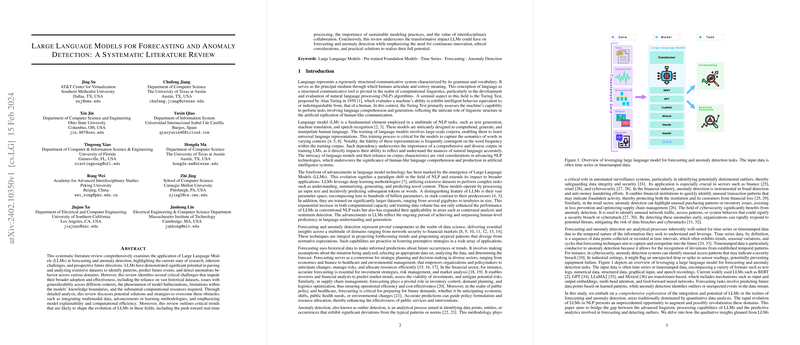Leveraging LLMs for Forecasting and Anomaly Detection: A Comprehensive Review
LLMs have increasingly become central to advancements in forecasting and anomaly detection across various domains. These models, which have initially been honed for a vast array of natural language processing tasks, are now being applied to parse extensive datasets, predict future events, and pinpoint anomalies with significant accuracy. This systematic literature review explores the current state of LLM applications in these areas, shedding light on methodologies, inherent challenges, and the promising horizon that lies ahead.
Current Methodologies and Applications
LLMs offer a robust framework for understanding and generating predictions based on historical data. In areas like time series forecasting, event sequence prediction, traffic flow forecasting, and healthcare clinical prediction, LLMs have shown their prowess. These applications leverage LLMs' ability to process and analyze massive amounts of data, identifying patterns and deviations that might elude traditional analysis methods.
Challenges Facing LLM Adoption
Despite their potential, the deployment of LLMs in forecasting and anomaly detection faces several hurdles. A significant dependency on extensive historical datasets presents challenges in data availability, quality, and inherent biases. Moreover, ensuring the generalizability of these models across diverse contexts remains a formidable task. Issues such as model hallucinations, where LLMs generate plausible but incorrect or misleading information, along with concerns over the robustness and computational efficiency of these models, further complicate their widespread adoption.
The Road Ahead: Future Directions
Emerging trends promise to address these challenges, broadening the scope and enhancing the performance of LLMs in forecasting and anomaly detection. Notably, the integration of multimodal data sources and advancements in transfer and meta-learning are poised to improve model adaptability and learning efficiency. Emphasis on model explainability and the push towards real-time processing underscore the growing need for LLMs that are not only accurate but are also transparent and capable of operating in dynamic environments. Furthermore, sustainable modeling practices highlight an increasing awareness of the environmental and ethical considerations surrounding LLM deployment.
Conclusion
The application of LLMs in forecasting and anomaly detection offers a glimpse into a future where predictive analytics is more sophisticated, accurate, and impactful. While challenges remain, the pathways to overcoming these obstacles are becoming increasingly clear, thanks to ongoing research and technological innovations. As we move forward, it is imperative that the development and deployment of LLMs continue to be guided by principles of ethical consideration, ensuring that these advances benefit society as a whole.
This comprehensive review underscores the transformative potential of LLMs in forecasting and anomaly detection, marking a significant step toward harnessing the full capabilities of advanced computational models to navigate the complexities of the modern world.
